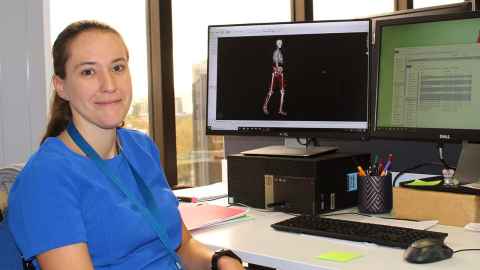Creating a Digital 'Mini Me'
28 September 2021
Bioengineer Dr Julie Choisne has been awarded an Aotearoa Fellowship for research aimed at developing what she calls a “Digi Mini Me” – a computational model of the physiology of a child.

Dr Choise was awarded the first of three Fellowships set up to enable an emerging scientist to undertake research for the 12 Labours project at the Auckland Bioengineering Institute (ABI)
The overall goal for the 12 Labours project, which has received $15 million of funding by the Ministry of Business, Innovation and Enterprise (MBIE), is to further advance the predictive modelling capability that the ABI and its international partners have developed to generate a ‘virtual human’ - an online computational modelling framework that integrates mathematical modelling and complex biology, capable of predicting how the health of a patient will evolve under certain conditions.
The 12 Labours Project is aimed at developing a clinically oriented framework for the physiological systems of the adult human body. ”But children are not small adults and can’t be represented using adult models,” says Dr Choisne. “So my proposal is to create a digital twin but for children – which I’ve called a Digi Mini Me.”
Dr Choisne’s research focuses on disorders of the musculoskeletal system, particularly in young children and adolescents.
As part of her Fellowship, she will be using computer modelling and imaging to continue to investigate issues related to bone deformation and movement disorder in children with cerebral palsy, a physical disability caused by damage to the brain during or soon after birth. She will also be focussing her research on finding biomarkers related to hip dysplasia and slipped capital femoral epiphysis (SCFE) for early diagnosis.
Children are not small adults and can’t be represented using adult models. So my proposal is to create a digital twin but for children – which I’ve called a 'Digi Mini Me'.”
Biomarkers are objective medical signs (as opposed to symptoms reported by the patient) used to measure the presence or progress of disease, or the effects of treatment. Dr Choisne is hoping to find specific biomarkers from wearable sensors and walking patterns in children with hip dysplasia and SCFE before symptoms appear and surgery is inevitable.
SCFE is a hip disorder seen predominantly in overweight adolescents that affects the femoral growth plate, creating a deformity in the proximal femoral neck. The prevalence SCFE is unfortunately high in NZ compared to other western countries.
It is currently difficult for clinicians to identify joint and muscle problems in young children, such as those with SCFE, says Dr Choisne, and early symptoms, such as pain, are often dismissed as ‘growing pains’.
“Until the pain gets so intense, that the person needs surgery to correct the problem, and that's not good, because they're going to have joint problems for the rest of their life as a result,” says Dr Choisne.
The first aim of her research is actually to understand what is considered ‘normal’, in bone and muscle growth in children at different ages, which is not well understood, she says.
“Understanding bone and muscle geometry of children during normal growth is important for understanding how these factors deviate in children with movement disorders – and to enable us to identify problems early on, and what interventions could help prevent them from worsening before it’s too late.”
The Fellowship will provide funding for four years’ salary, to supervise two PhD Students, and to cover the cost of a research assistant. “It gives me everything I need to get my research going.”
Media contact
Margo White I Media adviser
DDI 09 923 5504
Mob 021 926 408
Email margo.white@auckland.ac.nz